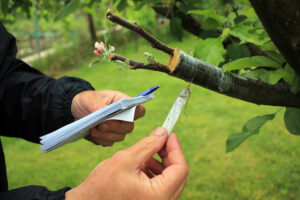This tool helps you estimate the weight of a tree based on its height, diameter, and wood density. Whether you’re managing forests, researching, or just curious, calculating tree weight can give you valuable insights into biomass, carbon storage, and resource management. To get started, simply enter the tree’s height (in meters), diameter (in centimeters), and the type of wood’s density (in kg/m³). With these inputs, our calculator provides a quick, accurate weight estimate. This information is essential for environmental studies, logging, and ecological assessments. Try it now and explore tree weight effortlessly!
Tree Weight Calculator
Formula for Tree Weight Calculation
To estimate the weight of a tree, we use the following formula:
$$[
\text{Tree Weight} = \text{Tree Volume} \times \text{Wood Density}
]$$
Breaking Down the Formula:
- Tree Volume (cubic meters): Approximated using the cylinder volume formula:
$$[
\text{Volume} = \pi \times \left(\frac{\text{Diameter}}{2}\right)^2 \times \text{Height}
]$$
- Diameter is the tree’s diameter at breast height (DBH) in meters (converted from centimeters).
- Height is the tree’s height in meters.
- (\pi) is a constant (approx. 3.14159).
- Wood Density (kg/m³): This is the density of the tree’s wood type, a standard value in kilograms per cubic meter (kg/m³). Different tree species have unique wood densities (e.g., oak is denser than pine).
Step-by-Step Calculation Example
Let’s calculate the approximate weight of an oak tree with the following details:
- Height: 10 meters
- Diameter: 30 centimeters
- Wood Density: 750 kg/m³ (an average density for oak)
Step 1: Convert Diameter to Meters
Since the diameter is given in centimeters, we convert it to meters:
$$[
\text{Diameter in meters} = 30 \, \text{cm} \div 100 = 0.3 \, \text{m}
]$$
Step 2: Calculate the Tree Volume
Now we use the volume formula:
$$[
\text{Volume} = \pi \times \left(\frac{\text{Diameter}}{2}\right)^2 \times \text{Height}
]$$
Substitute the values:
$$[
\text{Volume} = 3.14159 \times \left(\frac{0.3}{2}\right)^2 \times 10
]$$
Breaking this down:
- $$(\frac{0.3}{2} = 0.15)$$
- $$((0.15)^2 = 0.0225)$$
- $$(3.14159 \times 0.0225 = 0.07069)$$
- $$(0.07069 \times 10 = 0.7069)$$ cubic meters
So, the tree volume is approximately 0.7069 m³.
Step 3: Calculate the Tree Weight
Finally, we calculate the weight by multiplying the volume by the wood density:
$$[
\text{Weight} = \text{Volume} \times \text{Density}
]$$
$$[
\text{Weight} = 0.7069 \times 750 = 530.18 \, \text{kg}
]$$
Result:
The estimated weight of this oak tree is approximately 530.18 kg.
Summary of Calculation Steps
- Convert diameter to meters if needed.
- Calculate volume using tree height and diameter.
- Multiply volume by wood density to get the tree’s weight.
This formula provides an approximate weight, as actual weight can vary with tree structure and moisture content.
Here’s a table with some common tree species, their average weights, and additional facts:
| Tree Name | Average Weight (kg) | Facts |
|---|---|---|
| Oak | 2,400 – 4,500 | Known for its strength, often used in furniture and flooring. |
| Pine | 500 – 1,000 | Fast-growing, commonly used in construction and paper production. |
| Maple | 2,000 – 3,200 | Maple syrup is made from the sap of certain species. |
| Redwood | 10,000 – 30,000 | One of the tallest tree species, reaching up to 379 feet. |
| Birch | 500 – 900 | Known for its distinctive bark, often used in plywood. |
| Douglas Fir | 1,500 – 3,000 | Common in North America; valuable in the timber industry. |
| Eucalyptus | 1,200 – 3,000 | Known for rapid growth, used for essential oils and paper. |
| Sequoia | 50,000 – 80,000 | Among the heaviest trees, sequoias can live for thousands of years. |
| Cedar | 600 – 900 | Naturally resistant to decay, used in closets and chests. |
| Ash | 700 – 1,200 | Highly durable, commonly used for making tool handles and sports equipment. |
Weights are averages and vary based on age, size, and environmental factors.






